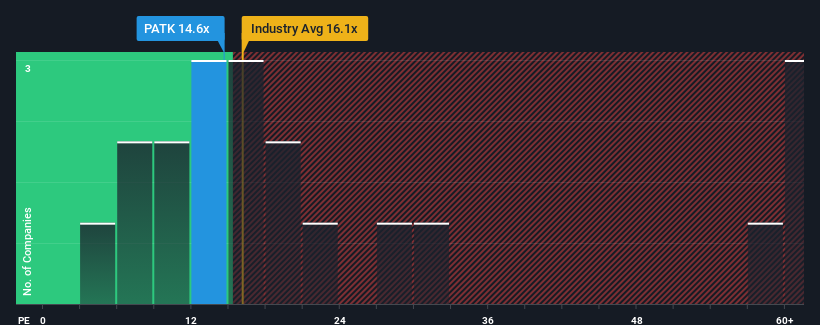- United States
- /
- Auto Components
- /
- NasdaqGS:PATK
Patrick Industries, Inc. (NASDAQ:PATK) Might Not Be As Mispriced As It Looks
When close to half the companies in the United States have price-to-earnings ratios (or "P/E's") above 17x, you may consider Patrick Industries, Inc. (NASDAQ:PATK) as an attractive investment with its 14.6x P/E ratio. However, the P/E might be low for a reason and it requires further investigation to determine if it's justified.
Recent times haven't been advantageous for Patrick Industries as its earnings have been falling quicker than most other companies. It seems that many are expecting the dismal earnings performance to persist, which has repressed the P/E. If you still like the company, you'd want its earnings trajectory to turn around before making any decisions. Or at the very least, you'd be hoping the earnings slide doesn't get any worse if your plan is to pick up some stock while it's out of favour.
View our latest analysis for Patrick Industries

How Is Patrick Industries' Growth Trending?
In order to justify its P/E ratio, Patrick Industries would need to produce sluggish growth that's trailing the market.
If we review the last year of earnings, dishearteningly the company's profits fell to the tune of 55%. However, a few very strong years before that means that it was still able to grow EPS by an impressive 98% in total over the last three years. Although it's been a bumpy ride, it's still fair to say the earnings growth recently has been more than adequate for the company.
Turning to the outlook, the next year should generate growth of 8.5% as estimated by the eight analysts watching the company. That's shaping up to be similar to the 10% growth forecast for the broader market.
In light of this, it's peculiar that Patrick Industries' P/E sits below the majority of other companies. It may be that most investors are not convinced the company can achieve future growth expectations.
The Key Takeaway
Generally, our preference is to limit the use of the price-to-earnings ratio to establishing what the market thinks about the overall health of a company.
Our examination of Patrick Industries' analyst forecasts revealed that its market-matching earnings outlook isn't contributing to its P/E as much as we would have predicted. When we see an average earnings outlook with market-like growth, we assume potential risks are what might be placing pressure on the P/E ratio. It appears some are indeed anticipating earnings instability, because these conditions should normally provide more support to the share price.
Having said that, be aware Patrick Industries is showing 4 warning signs in our investment analysis, you should know about.
It's important to make sure you look for a great company, not just the first idea you come across. So take a peek at this free list of interesting companies with strong recent earnings growth (and a low P/E).
New: Manage All Your Stock Portfolios in One Place
We've created the ultimate portfolio companion for stock investors, and it's free.
• Connect an unlimited number of Portfolios and see your total in one currency
• Be alerted to new Warning Signs or Risks via email or mobile
• Track the Fair Value of your stocks
Have feedback on this article? Concerned about the content? Get in touch with us directly. Alternatively, email editorial-team (at) simplywallst.com.
This article by Simply Wall St is general in nature. We provide commentary based on historical data and analyst forecasts only using an unbiased methodology and our articles are not intended to be financial advice. It does not constitute a recommendation to buy or sell any stock, and does not take account of your objectives, or your financial situation. We aim to bring you long-term focused analysis driven by fundamental data. Note that our analysis may not factor in the latest price-sensitive company announcements or qualitative material. Simply Wall St has no position in any stocks mentioned.
About NasdaqGS:PATK
Patrick Industries
Manufactures and distributes component products and materials for the recreational vehicle, marine, powersports, manufactured housing, and industrial markets in the United States, Mexico, China, and Canada.
Adequate balance sheet with moderate growth potential.
Similar Companies
Market Insights
Community Narratives



